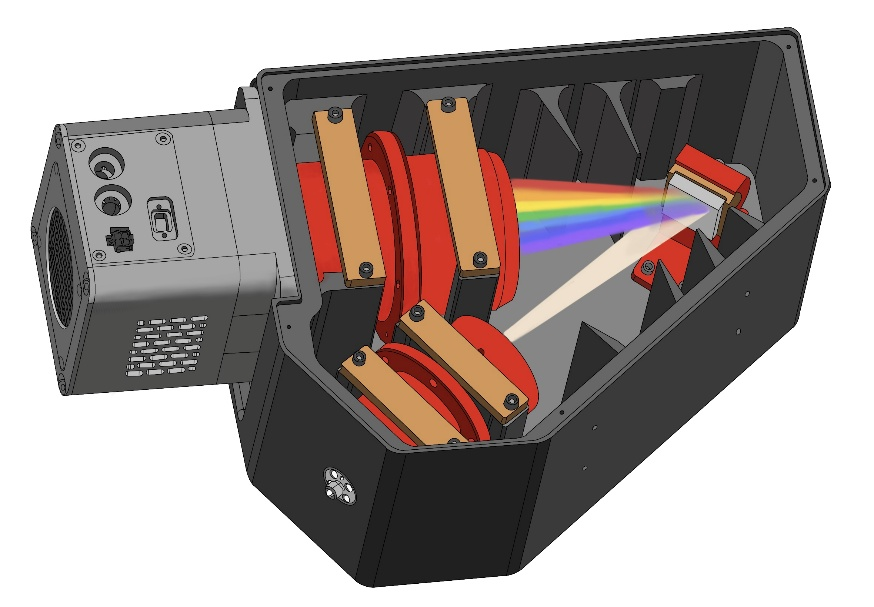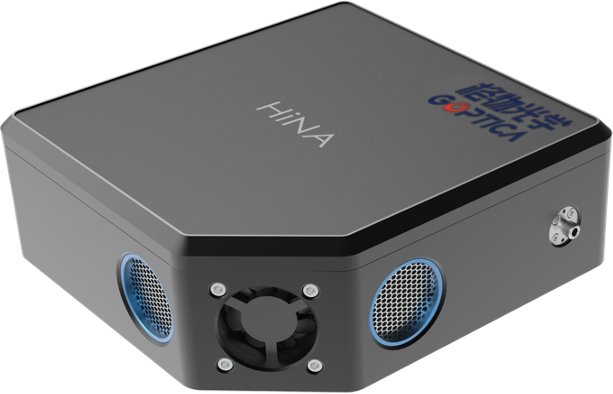Application Background
Spectrometers are widely used in the fields of physics, chemistry, biology, and especially micro-fiber spectrometers play an important role in these fields. However, many micro-fiber spectrometers still adopt the traditional CT (Czerny-Turner) optical path design. Although this design has a history of application, it also has some disadvantages. Firstly, the complexity of the optical path is a major problem in CT optical path design. Whether it is a crossed CT optical path or a non-crossed CT optical path, the optical path usually includes multiple mirrors and dispersion elements, which makes the construction and adjustment of the optical path relatively complex. This complexity not only increases the instability of the spectrometer but also brings higher maintenance requirements. Secondly, the insufficient light efficiency is also a major shortcoming of CT optical path. Due to multiple reflections in the optical path, the light signal will encounter higher losses during propagation. This loss may significantly affect the sensitivity of the spectrometer, thereby limiting its performance in weak signal detection.
To solve these problems, Goptica has launched the new HiNA spectrometer. The HiNA spectrometer, through innovative design, overcomes the disadvantages of traditional CT optical paths, achieving higher light efficiency and superior optical path configuration.
Product Features
The HiNA series spectrometers from Goptica feature innovative optical platform design and exceptional performance, providing users with higher sensitivity and accuracy.

Figure 1. HiNA optical path diagram
High Numerical Aperture Optical Path Design
The HiNA series spectrometers adopt an optical path design with at least a large numerical aperture (NA) of F/2. Compared to the compact fiber optic spectrometers with CT optical paths, this design not only significantly improves the light collection ability but also ensures a significant increase in light throughput and sensitivity under the same volume conditions. The advantages of this design include:
- Larger NA fiber matching: Supports fibers with higher numerical aperture (NA), achieving more efficient utilization of light energy.
- Efficient light energy utilization: The optical design maximizes the utilization of light signals, reducing the interference of scattered light. This increases the purity of the signal, reduces background noise, and thus improves the accuracy of spectral measurements.
- Adaptability to spatially emitting samples: Significantly improves the light collection efficiency for samples such as fluorescence, Raman, and microLED, enabling the capture of more light signals.
These features make the HiNA spectrometer perform exceptionally well in measuring weak signals, whether it is to accelerate the measurement speed under signals of the same intensity or to perform high-speed mapping or multiple averaging measurements, HiNA is more suitable.
Optimized Transmission Optical Path Design
The transmission optical path design of the HiNA spectrometer from Gouwu Optics is significantly superior to the traditional reflective optical path. Specifically, it includes:
- The light signal loss is smaller: The transmission optical path significantly reduces the loss of light passing through optical elements, effectively maintaining the light intensity. This makes the HiNA series have higher detection sensitivity and accuracy.
- Suitable for weak light signal detection: HiNA spectrometer can ensure accurate and fast measurement in various measurement scenarios of weak light signals such as fluorescence, Raman, and microLED.
Optical-electronic independent module design
Meanwhile, the HiNA series spectrometers also feature innovative modular design:
- Independent module design: The optical module and the detector module are relatively independent, supporting quick replacement of the detector.
- A wide range of detector options is provided, from uncooled detectors to thin back-illuminated cooled detectors, to deep cooled detectors, to meet the detection needs of different users.
This design not only improves the convenience of users when changing the spectrometer configuration, but also increases the stability of spectrometer assembly and use.
Actual Test Results
HiNA-F2 vs Imported Spectrometer (0.22 Numerical Aperture Fiber)
The following figure shows the intensity comparison data of HiNA-F2 and imported spectrometers under the same light source, the same fiber, and the same integration time. HiNA-F2 uses a 150um slit, while the imported spectrometer uses a 100um slit. Since the slit size and intensity are linearly correlated, the equivalent intensity of the 100um HiNA-F2 is about 66% of the green spectrum in the figure.
A rough comparison of the intensity at several wavelength positions:

Figure 2. Intensity comparison between HiNA-F2 and imported spectrometer
Device/Wavelength/Intensity | 675nm | 775nm | 875nm | 975nm |
(1) Imported Spectrometer with 100um Slit | ~2000 | ~3500 | ~4700 | ~4000 |
(2) HiNA with 150um Slit | ~17000 | ~37000 | ~46000 | ~23000 |
(3) HiNA with 100um Slit | ~11220 | ~24420 | ~30360 | ~15180 |
(3)/(1) (%) | 561% | 697% | 646% | 379% |
HiNA-F1 vs Imported Spectrometer (0.39 Numerical Aperture Fiber)
In another comparative experiment, we selected a fiber with a larger numerical aperture (NA=0.39) and conducted a comparative test on the same halogen lamp with an integrating sphere, the results are as follows:
 |
|  |
| Figure 3. Measurement results of HiNA-F1 combined with 0.39 numerical aperture fiber optics |
| Figure 4. Imported spectrometer, measurement results with 0.39 numerical aperture fiber |
The HiNA-F1 uses a 50um slit, while the imported spectrometer uses a 25um slit. Since the slit size and light intensity are linearly correlated, the HiNA-F1 with a 25um slit needs about twice the integration time to achieve the same light intensity as the experiment, that is, 20ms. Under these conditions, the sensitivity ratio between the HiNA-F1 and the imported spectrometer can be equated to the inverse ratio of their integration times, that is, 1600ms / 20ms = 80 times. It can be seen that with the support of larger numerical aperture optical design and larger numerical aperture fiber, the advantages of the HiNA system become extremely significant.
Summary and Outlook
The HiNA spectrometer features a high numerical aperture optical path and an optimized transmission optical path design, significantly enhancing the sensitivity and accuracy of spectral measurements, especially when dealing with weak signals and complex samples. This is of great significance for scientific research institutions, industrial applications, and quality control fields that require high sensitivity and high-precision analysis.
With the continuous advancement of technology, there is still room for improvement in the data processing speed, system integration, and user convenience of the HiNA spectrometer. In the future, by combining artificial intelligence and big data analysis technology, the HiNA spectrometer may achieve more intelligent analysis functions and further expand its application fields.
Related Products:
